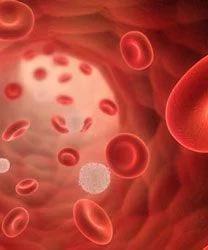Asciminib Emerges as a Potential Treatment Alternative in Heavily Pretreated CML
December 6, 2020 — The investigational TKI asciminib was found to be a safe and effective treatment for patients with chronic myeloid leukemia without any alternatives in clinical practice, particularly those with prior TKI intolerance and those who achieved prior complete cytogenetic response.

The investigational TKI asciminib (ABL001) was found to be a safe and effective treatment for patients with chronic myeloid leukemia (CML) without any alternatives in clinical practice, particularly those with prior TKI intolerance and those who achieved prior complete cytogenetic response (CCyR), according to findings from a real-world analysis that were presented during the 2020 ASH Annual Meeting.
The rates of complete hematologic response, CCyR, and major molecular response (MMR) pre- and post-asciminib, respectively, were 100%, 47% and 66%, and 17% and 41%. The probabilities of maintaining or improving CCyR responses among global, resistant, and intolerant patients were 48%, 33%, and 62%, respectively. The probabilities of maintaining or improving MMR responses among global, resistant, and intolerant patients were 33%, 11%, and 47%, respectively.
“The results endorse asciminib as a safe and efficacious drug for heavily pretreated CML patients,” said Alejandro Luna, MD, medical doctor of Hospital Universitario Ramón y Cajal in Madrid, Spain, in a virtual presentation of the data.
Despite the availability of TKIs, many patients with CML require additional therapies because of resistance or intolerance to approved drugs. To that end, in 2018, Novartis created a managed access program of asciminib for patients with CML who had failed all available TKIs and were not eligible for clinical trials.
Asciminib is a first-in-class STAMP (Specifically Targeting the ABL Myristoyl Pocket) inhibitor and has demonstrated activity in heavily pretreated patients with CML who developed resistance or unacceptable adverse effects (AEs) to previous therapy.
The objectives of the study were to analyze the efficacy and safety profile of the agent, describe patterns in prior TKI treatment lines, and evaluate cross intolerance.
The multicenter study compiled data from 27 centers in Spain on 31 patients with CML in chronic or accelerated phase. These patients, who had participated in the compassionate-use program, switched to asciminib upon intolerance or resistance to prior TKI therapy.
Follow-up occurred from October 2018 to May 2020.
The median patient age was 69 years (range, 22-89), and the majority of patients were female (n = 20; 65%). Patients had spent a median of 77 months on prior TKI therapy (range, 13-221).
All but 1 patient was in chronic phase (n = 30; 96%). The majority of patients had received at least 3 prior TKIs (n = 28; 90%), including ponatinib (Iclusig) in 35% of cases (n = 11). Regarding reasons for discontinuation, 9 patients (n = 29%) were switched to asciminib because of lack of efficacy, and 22 were switched because of lack of tolerability.
The mutational spread comprised T315I (n = 1; 3%), E255V (n = 2; 6%), exon 7 deletion (n = 1; 3%), and others (n = 6; 50%).
The median dose of asciminib was 40 mg twice daily, with the exception of the one patient with a T315I mutation who received 200 mg of asciminib twice daily.
Results from the multivariate analysis indicated that at least prior CCyR (10.5; 95% CI, 1.02-108.6) was the only factor that affected the improvement of response among resistance to prior TKI (0.6; 95% CI, 0.1-3.8), previous ponatinib (1.5; 95% CI, 0.22-10.3), and BCR-ABL mutations (10.5; 95% CI, 1.02-108.6).
At a median follow-up of 40 weeks, no patients had discontinued asciminib due to AEs. Two patients (6%) progressed to blastic phase, and 2 patients stopped the drug because of lack of efficacy; whereas, the majority of patients (n = 27; 87%) continued on asciminib.
Regarding safety, 18 patients (58%) had at least 1 any-grade treatment-emergent AE (TRAE), and 10 patients (32%) had at least 1 grade 3/4 TEAE.
The most common grade 1/2 AEs included appetite loss (3%), neutropenia (6%), joint pain (10%), nausea (10%), fatigue (10%), anemia (13%), and thrombocytopenia (23%). Grade 3/4 AEs included fatigue (3%), neutropenia (3%), and thrombocytopenia (10%).
Nine patients required dose adjustment, and 7 required temporal suspension.
Less severe AEs were reported with asciminib vs prior TKIs, and no vascular events were reported with the investigational TKI. In terms of cross intolerance, investigators reported 2 cases of fatigue, 1 case of pleural effusion, and 5 cases of cytopenia.
“Regarding general AEs, we see an overall reduction in all AEs with asciminib. However, thrombocytopenia is still common on asciminib in our sample,” said Luna. “Regarding severe AEs, we also see very important reductions in symptoms, which are a common cause for treatment discontinuation and also for life-threatening events, such as ischemic events and pleural effusion in patients on asciminib.”
Ongoing studies will provide information about which patients could benefit the most from asciminib, concluded Luna.
Reference
- Luna A, Estrada N, Boqué C, et al. Safety and efficacy of asciminib as treatment in chronic myeloid leukemia patients in real-life clinical practice. Presented at: ASH Annual Meeting 2020; December 5-8, 2020; virtual. Abstract 1241.



